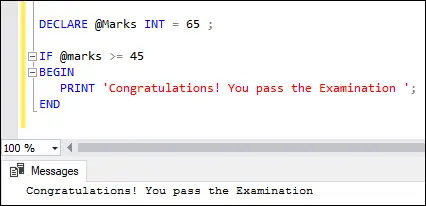Изявлението IF е част от функцията на контролния поток в SQL Server. Обикновено това е изявление за вземане на решение в различни езици за програмиране, което връща стойност въз основа на дадените условия . Този оператор изпълнява кода, написан в блок IF, когато даденото условие се изчисли като вярно и когато условието се изчисли като false, тогава ще се изпълни изразът ELSE.
Декларацията IF
По-долу е синтаксисът, който илюстрира използването на този израз в SQL Server:
IF boolean_expression BEGIN { statement_block } END В горния синтаксис, блок_изявление в НАЧАЛО...КРАЙ блок се изпълнява, когато булев_израз е доволен от състоянието. В противен случай този блок се пропуска и управлението на програмата се премества в оператора след КРАЙ ключова дума. Трябва да знаем, че ако изразът съдържа a ИЗБЕРЕТЕ изявление, ние трябва оградете ги в скоби .
Пример
Нека видим примера, за да разберем оператора IF без блок ELSE. Примерът по-долу ще покаже резултата, когато условието е изпълнено. В противен случай управлението на програмата се премества в израза след ключовата дума END, ако има такава.
DECLARE @Marks INT = 65 ; IF @marks >= 45 BEGIN PRINT 'Congratulations! You pass the Examination'; END
Изпълнението на оператора ще даде следния резултат:
алтернатива на mylivecricket

Сега ще го демонстрираме по-долу ' Студент' таблица със следните данни:

По-долу е друг пример, който получава общи оценки на избран ученик от „ Студент' таблица в примерната база данни и след това отпечатва a съобщение ако е по-голям от 400 .
BEGIN DECLARE @Total_Marks INT; SELECT @Total_Marks = total_marks FROM Student WHERE age>25; SELECT @Total_Marks; IF @Total_Marks > 400 BEGIN PRINT 'Congratulations! You pass the Examination'; END END
Ще получим изхода по-долу:

Ако искаме да видим горното изходно съобщение, трябва да щракнете върху Съобщения раздел:

Изявлението IF-ELSE
В сценария от реалния свят трябва да извършим някакво действие, когато условието в оператора IF е TRUE или FALSE. В този случай операторът IF…ELSE е полезен. Този оператор изпълнява блока с оператори ELSE, когато условието в клаузата IF е оценено като FALSE.
По-долу е синтаксисът, който илюстрира използването на израза IF ELSE в SQL Server :
IF expression BEGIN Statement block -- It executes when the IF clause expression is TRUE. END ELSE BEGIN Statement block -- It executes when the IF clause expression is FALSE. END
Пример
Нека видим примера, за да разберем израза IF с блок ELSE. Примерът по-долу ще покаже съобщението „ Честито! Издържате изпита ' когато условието IF е изпълнено. В противен случай покажете „ Вие сте провалени! По-добър късмет следващия път '.
DECLARE @Marks INT; SET @Marks = 65; IF @marks <45 begin print 'congratulations! you pass the examination'; end else 'you are failed! better luck next time'; < pre> <p>Executing the statement will give the below output. Here, the <strong>marks</strong> variable is <strong>65</strong> , and the <strong>condition (65<45)< strong> is not satisfied. Therefore, the message inside the ELSE block is displayed:</45)<></strong></p> <img src="//techcodeview.com/img/sql-server-tutorials/49/sql-server-if-else-5.webp" alt="SQL Server IF ELSE"> <p>We will get this output because the condition <strong>(65>45)</strong> is satisfied. Therefore, the message inside the IF block is displayed:</p> <img src="//techcodeview.com/img/sql-server-tutorials/49/sql-server-if-else-6.webp" alt="SQL Server IF ELSE"> <p>Now, we will demonstrate the IF ELSE statement on the above ' <strong>Student'</strong> table. In this example, we are going to check whether the student <strong>total marks</strong> is <strong>greater than or equal to 400</strong> or not as follows:</p> <ul> <li>When the IF condition is TRUE, we will get the student records whose total marks are greater than or equal to 550.</li> <li>If the condition is FALSE, we will get the student records whose total marks are less than 550.</li> </ul> <p>Here is the program:</p> <pre> DECLARE @Marks INT; SET @Marks = 600 ; IF @Marks >= 550 BEGIN SELECT id, name, gender, age, total_marks FROM Student WHERE total_marks >= 550 ORDER BY age ASC END ELSE BEGIN SELECT id, name, gender, age, total_marks FROM Student WHERE total_marks <550 order by age asc end < pre> <p>In this code, we have specified the <strong>@Marks</strong> variable to <strong>600</strong> , and the condition (600 >= 550) is satisfied. Therefore, we will get the output where student records whose total marks are greater than or equal to 550 are displayed.</p> <img src="//techcodeview.com/img/sql-server-tutorials/49/sql-server-if-else-7.webp" alt="SQL Server IF ELSE"> <p>If we changed the <strong>@Marks</strong> variable to <strong>500</strong> and the condition (500 >= 550) becomes false. Therefore, we will get the output where student records whose total marks are less than 550 are displayed.</p> <img src="//techcodeview.com/img/sql-server-tutorials/49/sql-server-if-else-8.webp" alt="SQL Server IF ELSE"> <h2>Nested IF ELSE Statement</h2> <p>Unlike other programming languages, we can nest an IF...ELSE statement inside another IF...ELSE statement in SQL Server. Let us demonstrate it with the following example:</p> <pre> DECLARE @age INT; SET @age = 6; IF @age <18 50 print 'you are underage'; else begin if @age < below 50'; senior cetizen'; end; pre> <p>In this example, we are going to check whether the <strong>age is underage, below 50, or senior citizen</strong> as follows:</p> <ul> <li>If the value of the <strong>@age</strong> variable is below <strong>18</strong> , it will print the person is <strong>underage</strong> .</li> <li>If the condition is FALSE, the ELSE part will be executed that has a nested IF…ELSE.</li> <li>If the value of the <strong>@age</strong> variable is under <strong>50</strong> , it will print <strong>below 50</strong> . Finally, if no condition is satisfied, it will print <strong>senior citizens</strong> .</li> </ul> <p>Here is the result:</p> <img src="//techcodeview.com/img/sql-server-tutorials/49/sql-server-if-else-9.webp" alt="SQL Server IF ELSE"> <p>This article gives a complete overview of how to use the SQL Server IF ELSE statement. Here we have learned:</p> <ul> <li>Variables are objects that serve as placeholders.</li> <li>The keyword BEGIN will be used to start a statement block, and the END keyword must be used to close it.</li> <li>The use of ELSE in an IF... ELSE statement is optional.</li> <li>It's also possible to nest an IF...ELSE statement inside another IF...ELSE statement. However, nesting an IF statement within another statement is bad practice because it makes the code difficult to read and maintain.</li> </ul> <hr></18></pre></550></pre></45>
